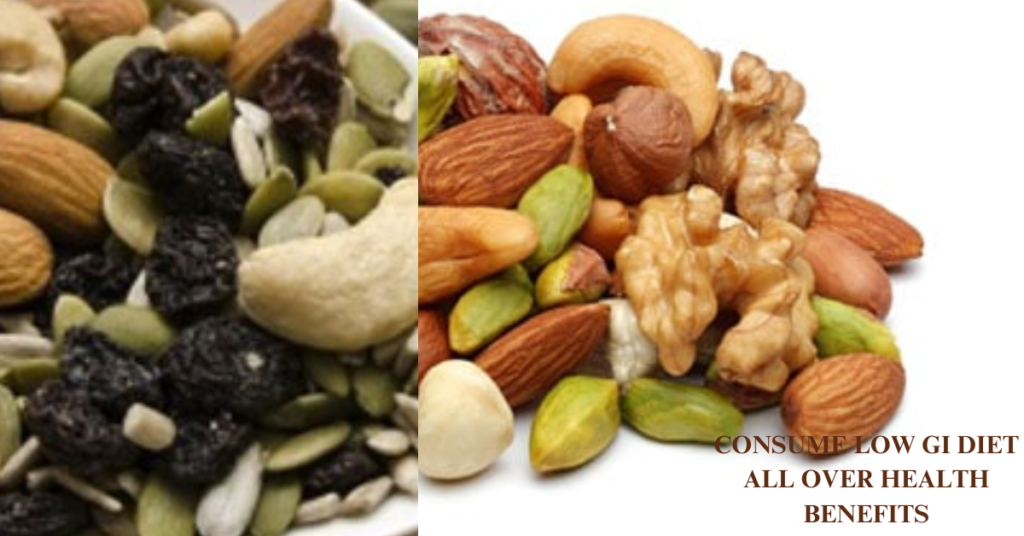Table of Contents
Power of the Low Glycemic Foods:
lies in their ability to stabilize blood sugar levels, sustain energy, and promote overall health. By choosing foods with a low glycemic index, such as whole grains, legumes, fruits, and vegetables, you can prevent spikes and crashes in blood sugar, maintain steady energy throughout the day, and reduce the risk of chronic diseases like diabetes and heart disease. Incorporating these nutrient-dense foods into your diet provides a foundation for optimal health and well-being, making them essential components of a balanced and nourishing eating plan.

The concept of glycemic index (GI) has emerged as a valuable tool in understanding how different foods affect blood sugar levels.The power of Low glycemic foods, with their slower digestion and absorption rates, have garnered attention for their numerous health benefits. In this article, we delve into the importance and advantages of incorporating low glycemic food items into your diet.
The glycemic index:

The glycemic index is a numerical ranking system that classifies carbohydrates based on their effect on blood glucose levels. Foods are assigned a power of GI value ranging from 0 to 100, with pure glucose assigned a value of 100, representing the standard against which all other foods are measured. Foods with a high GI (70 or above) are rapidly digested and cause a sharp increase in blood sugar levels, while those with a low GI (55 or below) are digested more slowly, leading to a gradual rise in blood sugar levels.
Importance of Low Glycemic Foods:
Blood Sugar Management:

One of the primary benefits of consuming low glycemic foods is their ability to help manage blood sugar levels. For individuals with diabetes or those at risk of developing the condition, maintaining stable blood sugar levels is crucial in preventing complications and managing the disease effectively. Low GI foods help achieve this by promoting gradual glucose release into the bloodstream, preventing sudden spikes and crashes in blood sugar levels.
Sustained Energy:
Unlike high glycemic foods, which can cause rapid fluctuations in energy levels, low glycemic foods provide sustained energy over a longer period. This sustained release of energy is particularly beneficial for maintaining focus and productivity throughout the day, without the accompanying feelings of fatigue or lethargy often experienced after consuming high GI foods.
Weight Management:

Incorporating low glycemic foods into your diet can also aid in weight management and appetite control. Foods with a low GI tend to be more filling and satiating, leading to reduced hunger and lower calorie intake. By helping regulate appetite and promoting feelings of fullness, low GI foods can support weight loss efforts and contribute to long-term weight management.
Heart Health:

Several studies have linked a diet rich in low glycemic foods to improved heart health. Power of the Low Glycemic Foods: By reducing the risk of insulin resistance and lowering levels of inflammatory markers in the body, low GI foods help protect against cardiovascular diseases such as heart disease and stroke. Additionally, the fiber-rich nature of many low GI foods promotes healthy cholesterol levels and supports overall heart function.
Improved Athletic Performance:
Athletes and fitness enthusiasts can benefit from including the power of the low glycemic foods in their pre- and post-workout meals. These foods provide a steady source of energy, helping to sustain endurance and performance during exercise while supporting optimal recovery and muscle repair afterward. Incorporating low GI carbohydrates into a balanced diet can enhance athletic performance and promote overall fitness and well-being.
Benefits of Specific Low Glycemic Foods:
Whole Grains:
Whole grains such as oats, barley, quinoa, and brown rice are excellent sources of low glycemic carbohydrates. Rich in fiber, vitamins, and minerals, whole grains provide sustained energy and promote digestive health. They are versatile ingredients that can be incorporated into a variety of dishes, from breakfast cereals to hearty salads and side dishes.
Legumes:
Beans, lentils, and chickpeas are nutrient-dense legumes with a low glycemic index. They are high in protein, fiber, and complex carbohydrates, making them an ideal choice for promoting satiety and supporting muscle growth and repair. Legumes are also affordable, environmentally sustainable, and can be prepared in numerous delicious ways, including soups, stews, and salads.
Fruits and Vegetables:
Most non-starchy fruits and vegetables have a low glycemic index, making them essential components of a balanced diet. These foods are rich in vitamins, minerals, antioxidants, and phytochemicals, which promote overall health and reduce the risk of chronic diseases. Incorporating a colorful array of fruits and vegetables into your meals ensures a diverse nutrient intake and adds flavor and texture to your diet.
Nuts and Seeds:
Nuts and seeds are nutrient-dense snacks that provide healthy fats, protein, and fiber. While they are calorie-dense, their low glycemic index and high satiety value make them a satisfying and nutritious option for snacking. Including a handful of nuts or seeds in your diet can help curb cravings and prevent overeating, contributing to weight management goals.

Conclusion:
Incorporating low glycemic foods into your diet offers a multitude of benefits for both short-term well-being and long-term health. From managing blood sugar levels and promoting sustained energy to supporting weight management and reducing the risk of chronic diseases, the importance and the Power of the low GI foods cannot be overstated. By prioritizing whole grains, legumes, fruits, vegetables, nuts, and seeds in your meals, you can harness the power of the low glycemic foods nutrition to optimize your health and vitality. Make informed choices about the foods you consume, and reap the rewards of a balanced and nourishing diet for years to come.


